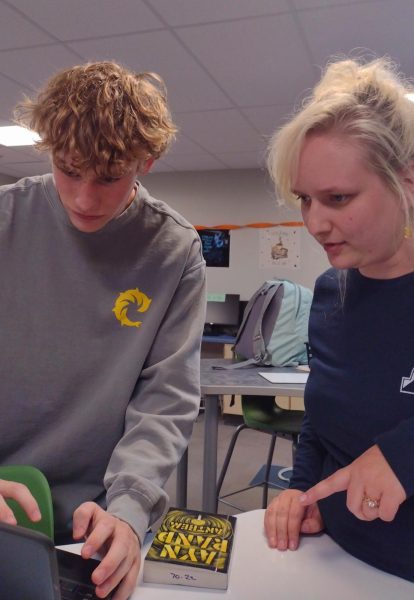To Text or Not to Text: The Distraction of Cell Phones

A student laughs at a new post, smiling as they carefully angle the phone away from their camera’s line of sight. Their attention is split with one ear on the lesson and everything else focused on the screen.
Games, social media, personal texts; all of these distractions take away from a student’s education. Phones in the classroom have become a widespread issue across the country, but the problems don’t end in the classroom alone.
“I have seen students bump into people and things because they are on their phone and not paying attention to where they are walking,” said geography teacher Rhonda Sorensen.
Imagining the danger this poses in and out of a school setting isn’t difficult. The dependency teenagers and young adults have developed for their technology is frightening. In the classroom, the distraction prevents students from finishing their work with their time being spent on handheld devices. Some students have even expressed discomfort when they forget their phones at home.
“If I forget my phone I’m a little more anxious. It doesn’t feel great as my phone is kind of a distraction from interacting with people,” said freshman Nilah Carroll.
Geography teacher Lee Routsong has also said that technology creates a different environment that’s not conducive to a proper education. However, he said that there isn’t anything that can be done to change the presence of phones in the classroom; students are capable of making the choice to pay attention or be on their phones.
“Your choices will impact your world,” Routsong said.
The school system, especially during the pandemic, has become dangerously reliant on technology. It creates even more of an excuse to have an eye on a phone at all times, regardless of whether it’s the right time to do so.
Most students say they spend between six and eight hours on their phones daily, as opposed to Sorensen’s estimate, which is only five hours.
Sorensen also said that she avoids phone usage during class hours, but her students don’t follow her example.
“Students use their phones continuously during class. Even with reminders to put them away, they are on their phones,” she said.
Enforcing the no phones rule has become impossible for teachers now that learning has moved to an online setting. Even more people have become immersed in the technological world, making it grow into an obsession.
When asked, students have admitted to spending less time with their family than normal because they can’t interact with their friends in person. That time is now being spent staring at the screen for hours at a time.
While phones do make it easier to interact with friends, it does create that temptation to ignore schoolwork and use that time for school to check social media. Some students say that they avoid using their phones unless they need it for classwork, but for the most part that isn’t the case.
“We have created a system that is so heavily dependent on Technology. Much of this is due to Covid, but some (of it) is that teachers like using the latest tech programs. We have, in a way, created a Tech dependency for kids,” said Routsong.
Cell phones are important for interacting with friends, especially now that it’s become more difficult to meet up in person. That doesn’t mean they belong in school.













